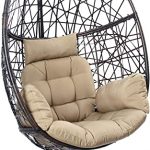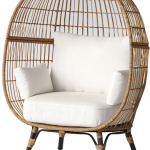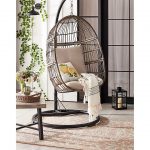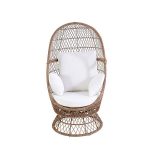When looking at the Egg Chair, it is hard to believe that its design is almost 60 years old. In the course of 6 decades the chair has neither aged nor become mundane. It still looks fresh and futuristic. The design was created by a Danish architect and designer, Arne Jacobsen, who is also responsible for many other iconic furniture designs.
history
The Egg Chair was developed together with the Swan Chair in 1958 to furnish the lobby of the Radisson Blu Royal Hotel in Copenhagen. The entire building, along with its interior and furnishings, was designed by Arne Jacobsen for the Scandinavian Airline System (SAS). While working on the hotel’s project, Jacobsen, who had worked as a landscape architect in the past, pursued a “modern garden” theme. This explains the organic, oval shape of the chair, which should fit the concept of the building.
The Egg Chair is still available in stores and is manufactured under the Republic of Fritz Hansen brand. The Danish furniture company started working with Arne Jacobsen in 1934. Since then, Jacobsen has provided the company with many memorable furniture designs, including the Ant: the Ant, the Series 7, the Grand Prix, the Swan and of course the legendary Egg.
design
Although many people would certainly get involved in polemics with the questionable appeal of the hotel as a structure, the design of the Egg Chair leaves no room for such a discussion. With its oval, futuristic shape, the chair is guaranteed to take a top spot in the list of the most iconic furniture designs of the 20th century. Rumor has it that Jacobsen was inspired by Eero Saarinen’s “Womb Chair”. On closer inspection of the two chairs, however, the alleged similarity is disputed. The shape of the Egg Chair with its famous slender curves has gained worldwide recognition and has been praised by many design critics.
The oval shell is made of a reinforced fiberglass composite that curves around the person sitting in it and gives the chair its famous cozy, intimate feeling. The shell is padded with cold-hardened foam, which is a little thicker in the area of ??the headrest, in order to increase the comfort of the chair. It is either upholstered in a variety of fabrics or leather. The front part of the upholstery is glued to the upholstery of the chair to reduce seams, folds and wrinkles. The back part is pulled firmly against the shell, which stretches the fabric (or leather) and makes it look very smooth. In the case of the leather variant, the considerable size of the egg chair requires the use of two cowhide leathers that must be sewn together on the sides of the chair. The type of seams used in making the Egg Chair out of leather make the seam line wavy, which is very characteristic of this design. The first models of the Egg Chair did not have a seat pad. This feature was added later to make the chair more comfortable. The egg stands on a four-legged base and rotates according to the mood of its owner. The base is made of polished aluminum, which is mounted on a satined steel base. A serial number is engraved on one of the prongs proving the authenticity of the chair. During the making of the egg, some of the chairs were fitted with a reclining mechanism, with the steel handle sticking out of the side of the chair. It is used to adjust the pressure required to lean the chair backwards.
In summary, the Egg Chair is a truly iconic piece of furniture that is always fun. Its innovative, futuristic design, combined with the impeccable quality of craftsmanship, has given the chair a very special place in the history of interior design.
 decorafit.com Design ideas for your home and patio
decorafit.com Design ideas for your home and patio








